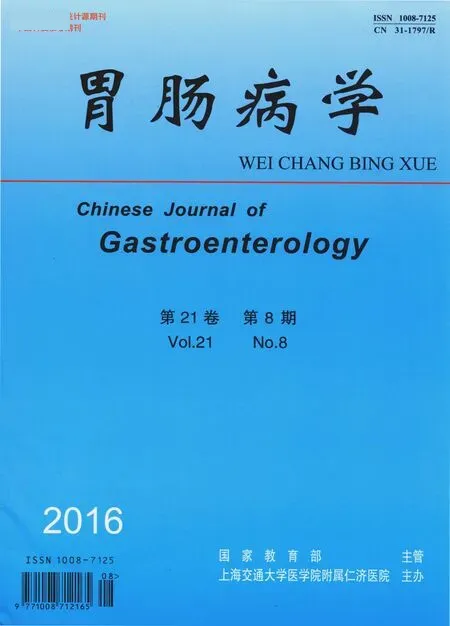吗啡引起术后肠梗阻的机制及其处理方法的研究进展
赵 晶 汪 艳 许 涛 江 伟
上海交通大学附属第六人民医院麻醉科(200233)
吗啡引起术后肠梗阻的机制及其处理方法的研究进展
赵晶汪艳许涛江伟*
上海交通大学附属第六人民医院麻醉科(200233)
术后肠梗阻(POI)是指腹部或非腹部手术后胃肠道协调运动功能暂时性受抑制的一种病理状态。POI 持续时间是决定患者术后住院时间的主要因素之一。近年来由于阿片类镇痛药物在临床广泛使用,吗啡引起的POI较为常见。本文就吗啡引起POI的机制及其处理方法的研究进展作一综述。
肠假性梗阻;肠道动力;镇痛药, 阿片类;吗啡;治疗
术后肠梗阻(postoperative ileus, POI)又称术后肠麻痹,是指腹部或非腹部手术后胃肠道协调运动功能暂时性受抑制的一种病理状态。POI 持续时间是决定患者术后(尤其是腹部手术后)住院时间的主要因素之一。近年来由于阿片类镇痛药物在临床广泛使用,包括术中和术后镇痛,吗啡引起的POI较为常见。本文就吗啡引起POI的机制及其处理方法的研究进展作一综述。
一、POI的定义及其特征
POI 是指手术后因消化道动力障碍使胃肠道内气体和液体蓄积导致胃肠道传输变缓和术后排便延迟,是胃肠道动力的功能性改变,而非机械性梗阻。1906 年Cannon 和Murphy首次对其进行定义,并认为该病是手术创伤打击后不可避免的[1]。小肠是胃肠道术后首先恢复功能的器官,术后数小时内即可恢复功能;其次是胃,约24~48 h恢复功能;最后是结肠,约48~72 h恢复功能,因此POI 主要发生于结肠[2]。POI的特征主要表现为:①发生时间持续至术后第3 d或3 d以上;②发病原因包括神经源性、炎症性、激素性以及术中阿片类药物的使用[3];③临床表现为腹胀、恶心、呕吐、肛门排便、排气延迟,最为突出的表现为对固体食物不耐受,肠内营养时间延长;④绝大多数患者经非手术治疗均可治愈,仅极少数患者需手术探查[4]。
二、吗啡引起POI背景介绍
POI 在各种手术中均有发生,以腹部肠道手术多见。美国一项包含806 081例手术患者的回顾性调查[5]显示,POI的平均发生率为4.55%,其中开腹手术为9.01%,腹腔镜手术为3.61%,胸部手术为1.57%,矫形手术为1.44%。发生POI患者的平均住院天数为9.3 d,平均单次住院费用为18 000 美元,而未发生POI患者的平均住院天数为5.3 d,平均单次住院费用为11 700美元。Hiranyakas等[6]行回顾性分析显示,2004年1月1日—2004年12月31日全美国腹部相关手术(包括腹式全子宫切除、结肠切除、小肠切除、胆囊切除、阑尾切除、肾输尿管切除等)中,发生POI患者的平均住院天数为11.5 d,显著长于未发生POI的患者(5.5 d);发生POI患者的平均住院费用为18 877美元,显著高于未发生POI的患者(9 460美元)。目前吗啡等阿片类镇痛药在围手术期广泛使用,本研究团队[7]发现,麻醉和术后镇痛过程中使用阿片类药物会延缓胃排空和结肠蠕动;POI持续时间与围手术期阿片类药物用量相关。
三、阿片类药物作用于胃肠道的机制
肠神经系统中包含3 种阿片受体,即μ、 κ、δ受体,其中μ阿片受体为主要受体,其可通过多种信号途径作用于肠肌丛细胞,包括抑制钾、钙离子通道、细胞膜超极化以及环磷腺苷生成等。阿片类药物与肠道阿片受体结合后可减缓肠蠕动,增加肠壁平滑肌张力,促进非蠕动性收缩。手术创伤可刺激内源性阿片类物质分泌,其与胃肠道μ阿片受体结合后可抑制胃肠道运动。
内源性阿片类物质包括内啡肽、脑啡肽和强啡肽,三者可选择性作用于μ、δ、κ、σ阿片受体。外源性阿片受体激动剂如吗啡主要作用于μ受体。μ受体在中枢和外周神经系统均有分布,在胃肠道不同位置的分布有所不同。与结直肠相比,μ受体在小肠中的比例更高,在间质细胞、平滑肌细胞、黏膜下神经丛均有表达[8-9]。
内源性阿片类物质在胃肠道生理活动中的作用未完全阐明。Sternini等[10]的研究显示,健康志愿者服用阿片受体拮抗剂纳洛酮后,胃肠道内容物通过时间缩短,提示内源性阿片类物质在胃肠道正常生理活动中发挥重要作用。
外源性阿片类激动剂可通过中枢和外周神经系统对胃肠道发挥作用。通过鞘内注射阿片类药物,可导致胃肠道运动和小肠分泌功能受抑制[11]。Camilleri[12]指出,作用于外周神经系统的阿片类物质拮抗剂可抑制阿片类物质介导的胃肠道运动减慢。Thomas[13]指出,阿片类物质可通过抑制乙酰胆碱释放,使胃肠道纵行平滑肌松弛;通过抑制血管活性肠肽(VIP)和一氧化氮分泌,使胃肠道环形平滑肌紧张。在外源性阿片类物质的作用下,胃、小肠和结直肠均可发生运动障碍。Wood等[14]指出,吗啡通过作用于肠神经系统中间神经元和黏膜下神经元的μ受体,从而激活钾离子通道,抑制钙离子通道,引起胃肠道运动障碍。此外,阿片类物质在减少胃肠道分泌方面亦发挥直接作用,其可抑制包括VIP、前列腺素E1和腺苷一磷酸诱导的分泌作用,此种阿片类物质介导的分泌抑制作用可被5-羟色胺和肾上腺素能受体拮抗剂抑制,提示5-羟色胺和去甲肾上腺素是阿片类物质作用的下游介质。
四、POI的处理方法
目前POI尚无统一规范的治疗标准,临床主要采用非手术治疗,包括:①胃肠减压:胃肠减压作为经验性治疗被外科医师推崇,认为其不仅可加速POI 缓解,亦可减少感染和吻合口瘘等并发症的发生。然而诸多学者[15-17]指出,胃肠减压可降低术后患者腹胀、呕吐的发生率,但并不能促进POI 缓解。目前除胃、十二指肠手术患者出现严重呕吐和腹胀需行胃肠减压外,其余手术术后已不推荐常规应用胃肠减压。②纠正水、电解质和酸碱失衡,有利于胃肠道功能恢复。③早期喂养:传统观念认为术后早期应严格禁食,以促进肠道功能恢复。但研究[18-19]指出,术后早期施行肠内营养能显著缩短肠道功能恢复时间。早期喂养可刺激胃肠道神经反射和激素释放,促进胃肠道蠕动,加速胃肠推进。Ng等[20]通过回顾性分析认为,结直肠手术患者术后尽早进食是安全、可耐受的,可缩短患者POI 持续时间和术后住院天数。④非甾体消炎药:Sim等[21]的研究显示,环氧合酶-2(COX-2)抑制剂可减少术后阿片类镇痛剂的用量,缩短患者住院时间。⑤早期下床活动:术后早期下床活动可刺激胃肠道蠕动,减少其他并发症,但目前仍无研究证实术后早期下床活动可缩短POI 持续时间。Schuster等[22]指出,术后及早下床活动可减少术后并发症的发生,但对POI无缓解作用。⑥阿片受体拮抗剂:纳络酮等非选择性阿片受体拮抗剂可促进胃肠道运动,但对吗啡依赖的患者可引起全身或局部胃肠道戒断症状[23]。使用选择性胃肠道类阿片受体拮抗剂如爱维莫潘可避免戒断症状,但可见恶心、呕吐、低血压等不良反应[24]。⑦硬膜外麻醉和镇痛:硬膜外镇痛法可阻断胃肠道传入神经和传出神经抑制性反射,增加内脏血流。研究[25]显示,腹部手术患者行局部麻醉药硬膜外麻醉术后平均胃肠道功能恢复时间为24 h,而行全身阿片类麻醉药麻醉术后平均胃肠道功能恢复时间为37 h。胸段硬膜外阻滞复合全身麻醉术可减轻术后应激反应,抑制细胞因子产生,获得更好的镇痛效果,从而减少术后阿片类镇痛药物的使用剂量,缩短术后肠道功能恢复时间[26]。⑧生长激素促分泌素受体激动剂ghrelin:ghrelin作为一种新型脑肠肽,是迄今为止发现的生长激素促分泌素受体的惟一天然配体,目前在多种胃肠道动力性疾病治疗方面取得了积极效果。Depoortere等[27]的研究表明,ghrelin可增加术后胃肠麻痹大鼠的结肠动力。Masuda等[28]的研究发现,乌拉坦麻醉大鼠静脉注射ghrelin后,大鼠胃排空加快,且呈明显量效关系。Trudel等[29]对POI大鼠静脉注射ghrelin后发现,大鼠胃排空和小肠流质饮食转运加快,同时可逆转POI。此外,本研究团队[30]发现,ghrelin可增加吗啡肠麻痹小鼠的结肠动力。
五、结语
综上所述,目前吗啡等阿片类镇痛药物在围手术期广泛使用,阿片样物质诱导术后肠功能障碍亦经常发生。有效减少POI持续时间可加快术后恢复、减少住院时间和住院费用。然而,目前POI的治疗缺乏统一标准,需更多临床和药物试验进一步研究。
1 Holte K, Kehlet H. Postoperative ileus: progress towards effective management[J]. Drugs, 2002, 62 (18): 2603-2615.
2 Luckey A, Livingston E, Taché Y. Mechanisms and treatment of postoperative ileus[J]. Arch Surg, 2003, 138 (2): 206-214.
3 Artinyan A, Nunoo-Mensah JW, Balasubramaniam S, et al. Prolonged postoperative ileus-definition, risk factors, and predictors after surgery[J]. World J Surg, 2008, 32 (7): 1495-1500.
4 Greenwood-Van Meerveld B. Emerging drugs for postoperative ileus[J]. Expert Opin Emerg Drugs, 2007, 12 (4): 619-626.
5 Gannon RH. Improving the management of postoperative ileus: Impact on clinical and economic outcomes[J]. Am J Health Syst Pharm, 2007, 64 (Suppl 13): S1-S23.
6 Hiranyakas A, Bashankaev B, Seo CJ, et al. Epidemiology, pathophysiology and medical management of postoperative ileus in the elderly[J]. Drugs Aging, 2011, 28 (2): 107-118.
7 赵晶,姚敬. 肝胆术后不同镇痛方式对患者胃肠动力的影响[J]. 蚌埠医学院学报, 2012, 37 (1): 27-28, 32.
8 Nishiwaki H, Saitoh N, Nishio H, et al. Possible role of potassium channels in mu-receptor-mediated inhibition and muscarinic autoinhibition in acetylcholine release from myenteric plexus of guinea pig ileum[J]. Jpn J Pharmacol, 2000, 82 (4): 343-349.
9 Matsumoto K, Umemoto H, Mori T, et al. Differences in the morphine-induced inhibition of small and large intestinal transit: Involvement of central and peripheral μ-opioid receptors in mice[J]. Eur J Pharmacol, 2016, 771: 220-228.
10Sternini C, Patierno S, Selmer IS, et al. The opioid system in the gastrointestinal tract[J]. Neurogastroenterol Motil, 2004, 16 Suppl 2: 3-16.
11Al-Khrasani M, Lackó E, Riba P, et al. The central versus peripheral antinociceptive effects of μ-opioid receptor agonists in the new model of rat visceral pain[J]. Brain Res Bull, 2012, 87 (2-3): 238-243.
12Camilleri M. Opioid-induced constipation: challenges and therapeutic opportunities[J]. Am J Gastroenterol, 2011, 106 (5): 835-842.
13Thomas J. Opioid-induced bowel dysfunction[J]. J Pain Symptom Manage, 2008, 35 (1): 103-113.
14Wood JD, Galligan JJ. Function of opioids in the enteric nervous system[J]. Neurogastroenterol Motil, 2004, 16 Suppl 2: 17-28.
15Park HK, Kwak C, Byun SS, et al. Early removal of nasogastric tube after cystectomy with urinary diversion: does postoperative ileus risk increase?[J]. Urology, 2005, 65 (5): 905-908.
16Nelson R, Tse B, Edwards S. Systematic review of prophylactic nasogastric decompression after abdominal operations[J]. Br J Surg, 2005, 92 (6): 673-680.
17Nelson R, Edwards S, Tse B. Prophylactic nasogastric decompression after abdominal surgery[J]. Cochrane Database Syst Rev, 2005 (1): CD004929.
18Mangesi L, Hofmeyr GJ. Early compared with delayed oral fluids and food after caesarean section[J]. Cochrane Database Syst Rev, 2002 (3): CD003516.
19Johnson Casto C, Krammer J, Drake J. Postoperative feeding: a clinical review[J]. Obstet Gynecol Surv, 2000, 55 (9): 571-573.
20Ng WQ, Neill J. Evidence for early oral feeding of patients after elective open colorectal surgery: a literature review[J]. J Clin Nurs, 2006, 15 (6): 696-709.
21Sim R, Cheong DM, Wong KS, et al. Prospective randomized, double-blind, placebo-controlled study of pre- and postoperative administration of a COX-2-specific inhibitor as opioid-sparing analgesia in major colorectal surgery[J]. Colorectal Dis, 2007, 9 (1): 52-60.
22Schuster TG, Montie JE. Postoperative ileus after abdominal surgery[J]. Urology, 2002, 59 (4): 465-471.
23Brock C, Olesen SS, Olesen AE, et al. Opioid-induced bowel dysfunction: pathophysiology and management[J]. Drugs, 2012, 72 (14): 1847-1865.
24Delaney CP, Weese JL, Hyman NH, et al. Phase Ⅲ trial of alvimopan, a novel, peripherally acting, mu opioid antagonist, for postoperative ileus after major abdominal surgery[J]. Dis Colon Rectum, 2005, 48 (6): 1114-1125.
25Jørgensen H, Wetterslev J, Møiniche S, et al. Epidural local anaesthetics versus opioid-based analgesic regimens on postoperative gastrointestinal paralysis, PONV and pain after abdominal surgery[J]. Cochrane Database Syst Rev, 2000 (4): CD001893.
26赵晶, 许涛, 江伟. 胸段硬膜外麻醉的非镇痛作用[J]. 国际麻醉学与复苏杂志, 2010, 31 (1): 56-59.
27Depoortere I, De Winter B, Thijs T, et al. Comparison of the gastroprokinetic effects of ghrelin, GHRP-6 and motilin in ratsinvivoandinvitro[J]. Eur J Pharmacol, 2005, 515 (1-3): 160-168.
28Masuda Y, Tanaka T, Inomata N, et al. Ghrelin stimulates gastric acid secretion and motility in rats[J]. Biochem Biophys Res Commun, 2000, 276 (3): 905-908.
29Trudel L, Tomasetto C, Rio MC, et al. Ghrelin/motilin-related peptide is a potent prokinetic to reverse gastric postoperative ileus in rat[J]. Am J Physiol Gastrointest Liver Physiol, 2002, 282 (6): G948-G952.
30赵晶,汪艳,许涛,等. Ghrelin对吗啡肠麻痹小鼠结肠动力的影响[J]. 上海交通大学学报(医学版), 2015, 35 (11): 1687-1690.
(2015-10-21收稿;2015-11-07修回)
Progress in Study on Mechanism and Management of Postoperative Ileus Caused by Morphine
ZHAO Jing, WANG Yan, XU Tao, JIANG Wei.
Department of Anesthesiology, the Sixth People’s Hospital, Shanghai Jiao Tong University, Shanghai (200233)Correspondence to: JIANG Wei, Email: jiangw@sjtu.edu.cn
Postoperative ileus (POI) is a temporary impairment of coordinated gastrointestinal motility that develops as a consequence of abdominal or non-abdominal surgery and is a major factor contributing to the prolonged hospitalization of patient. In recent years, because of the widespread use of opioid analgesics, morphine induced POI is common. This article reviewed the progress in study on mechanism and management of POI caused by morphine.
Intestinal Pseudo-Obstruction;Intestinal Motility;Analgesics, Opioid;Morphine;Therapy
10.3969/j.issn.1008-7125.2016.08.013
*本文通信作者,Email: jiangw@sjtu.edu.cn

